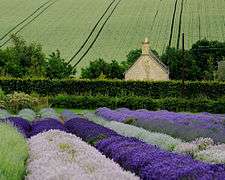Lavandula
Lavandula (common name lavender) is a genus of 47 known species of flowering plants in the mint family, Lamiaceae. It is native to the Old World and is found in Cape Verde and the Canary Islands, and from Europe across to northern and eastern Africa, the Mediterranean, southwest Asia to southeast India.[2]
| Lavender | |
|---|---|
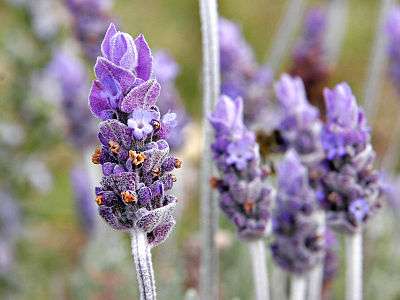 | |
| Lavender flowers with bracts | |
| Scientific classification | |
| Kingdom: | Plantae |
| Clade: | Tracheophytes |
| Clade: | Angiosperms |
| Clade: | Eudicots |
| Clade: | Asterids |
| Order: | Lamiales |
| Family: | Lamiaceae |
| Subfamily: | Nepetoideae |
| Tribe: | Ocimeae |
| Genus: | Lavandula L. |
| Type species | |
| Lavandula spica | |
| Synonyms[1] | |
| |
Many members of the genus are cultivated extensively in temperate climates as ornamental plants for garden and landscape use, for use as culinary herbs, and also commercially for the extraction of essential oils.[3] The most widely cultivated species, Lavandula angustifolia, is often referred to as lavender, and there is a color named for the shade of the flowers of this species. Despite its use over centuries in traditional medicine and cosmetics, there is no high-quality clinical evidence that lavender has any effects on diseases or improves health.[4][5]
Description
The genus includes annual or short-lived herbaceous perennial plants, and shrub-like perennials, subshrubs or small shrubs.[6]
Leaf shape is diverse across the genus. They are simple in some commonly cultivated species; in other species, they are pinnately toothed, or pinnate, sometimes multiple pinnate and dissected. In most species the leaves are covered in fine hairs or indumentum, which normally contain the essential oils.[6]
Flowers are borne in whorls, held on spikes rising above the foliage, the spikes being branched in some species. Some species produce coloured bracts at the apices. The flowers may be blue, violet or lilac in the wild species, occasionally blackish purple or yellowish. The calyx is tubular. The corolla is also tubular, usually with five lobes (the upper lip often cleft, and the lower lip has two clefts).[6][7]
Nomenclature and taxonomy
Lavandula stoechas, L. pedunculata and L. dentata were known in Roman times.[8] From the Middle Ages onwards, the European species were considered two separate groups or genera, Stoechas (L. stoechas, L. pedunculata, L. dentata) and Lavandula (L. spica and L. latifolia), until Linnaeus combined them. He only recognised five species in Species Plantarum (1753), L. multifida and L. dentata (Spain) and L. stoechas and L. spica from Southern Europe. L. pedunculata was included within L. stoechas.
By 1790, L. pinnata and L. carnosa were recognised. The latter was subsequently transferred to Anisochilus. By 1826 Frédéric Charles Jean Gingins de la Sarraz listed 12 species in three sections, and by 1848 eighteen species were known.[8]
One of the first modern major classifications was that of Dorothy Chaytor in 1937 at Kew. The six sections she proposed for 28 species still left many intermediates that could not easily be assigned. Her sections included Stoechas, Spica, Subnudae, Pterostoechas, Chaetostachys and Dentatae. However all the major cultivated and commercial forms resided in the Stoechas and Spica sections. There were four species within Stoechas (Lavandula stoechas, L. dentata, L. viridis and L. pedunculata) while Spica had three (L. officinalis (now L. angustifolia), L. latifolia and L. lanata). She believed that the garden varieties were hybrids between true lavender L. angustifolia and spike lavender (L. latifolia). [9]
Lavandula has three subgenera:
- Subgenus Lavandula is mainly of woody shrubs with entire leaves. It contains the principal species grown as ornamental plants and for oils. They are found across the Mediterranean region to northeast Africa and western Arabia.
- Subgenus Fabricia consists of shrubs and herbs, and it has a wide distribution from the Atlantic to India. It contains some ornamental plants.
- Subgenus Sabaudia constitutes two species in the southwest Arabian peninsula and Eritrea, which are rather distinct from the other species, and are sometimes placed in their own genus Sabaudia.
In addition, there are numerous hybrids and cultivars in commercial and horticultural usage.[6]
The first major clade corresponds to subgenus Lavandula, and the second Fabricia. The Sabaudia group is less clearly defined. Within the Lavandula clade, the subclades correspond to the existing sections, but place Dentatae separately from Stoechas, not within it. Within the Fabricia clade, the subclades correspond to Pterostoechas, Subnudae, and Chaetostachys.
Thus the current classification includes 39 species distributed across 8 sections (the original 6 of Chaytor and the two new sections of Upson and Andrews), in three subgenera (see table below). However, since lavender cross-pollinates easily, countless variations present difficulties in classification.
Etymology
The English word lavender is generally thought to be derived from Old French lavandre, ultimately from the Latin lavare (to wash), referring to the use of infusions of the plants.[10] The botanic name Lavandula as used by Linnaeus is considered to be derived from this and other European vernacular names for the plants. However it is suggested that this explanation may be apocryphal, and that the name may be derived from Latin livere, "blueish".[11]
The names widely used for some of the species, "English lavender", "French lavender" and "Spanish lavender" are all imprecisely applied. "English lavender" is commonly used for L. angustifolia, though some references say the proper term is "Old English Lavender".[12] The name "French lavender" may refer to either L. stoechas or to L. dentata. "Spanish lavender" may refer to L. stoechas, L. lanata or L. dentata.
Cultivation
The most common form in cultivation is the common or English lavender Lavandula angustifolia (formerly named L. officinalis). A wide range of cultivars can be found. Other commonly grown ornamental species are L. stoechas, L. dentata, and L. multifida (Egyptian lavender).
Because the cultivated forms are planted in gardens worldwide, they are occasionally found growing wild as garden escapes, well beyond their natural range. Such spontaneous growth is usually harmless, but in some cases Lavandula species have become invasive. For example, in Australia, Lavandula stoechas has become a cause for concern; it occurs widely throughout the continent, and has been declared a noxious weed in Victoria since 1920.[13] It is regarded as a weed in parts of Spain.[14]
Lavenders flourish best in dry, well-drained, sandy or gravelly soils in full sun.[15] All types need little or no fertilizer and good air circulation. In areas of high humidity, root rot due to fungus infection can be a problem. Organic mulches can trap moisture around the plants' bases, encouraging root rot. Gravelly materials such as crushed rocks give better results.[16] It grows best in soils with a pH between 6 and 8.[17] Most lavender is hand-harvested, and harvest times vary depending on intended use.[17]
Lavender oil
Commercially, the plant is grown mainly for the production of lavender essential oil of lavender. English lavender (Lavandula angustifolia) yields an oil with sweet overtones, and can be used in balms, salves, perfumes, cosmetics, and topical applications.[4] Lavandula × intermedia, also known as lavandin or Dutch lavender, yields a similar essential oil, but with higher levels of terpenes including camphor, which add a sharper overtone to the fragrance.
The lavandins Lavandula × intermedia are a class of hybrids of L. angustifolia and L. latifolia.[18] The lavandins are widely cultivated for commercial use, since their flowers tend to be bigger than those of English lavender and the plants tend to be easier to harvest, but lavandin oil is regarded by some to be of a lower quality than that of English lavender, with a perfume less sweet.[19]
The US Food and Drug Administration considers lavender as generally recognized as safe (GRAS) for human consumption.[20] The essential oil was used in hospitals during World War I.[15]
Phytochemicals
Some 100 individual phytochemicals have been extracted from lavender oil, including major contents of linalyl acetate (30-55%), linalool (20-35%), tannins (5-10%), and caryophyllene (8%), with lesser amounts of sesquiterpenoids, perillyl alcohols, esters, oxides, ketones, cineole, camphor, beta-ocimene, limonene, caproic acid, and caryophyllene oxide.[4][20][21] The relative amounts of these compounds vary considerably among lavender species.[4]
Culinary use
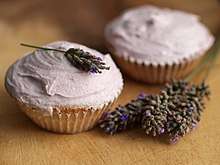
Culinary lavender is usually English lavender, the most commonly used species in cooking (L. angustifolia 'Munstead'). As an aromatic, it has a sweet fragrance with lemon or citrus notes.[22] It is used as a spice or condiment in pastas, salads and dressings, and desserts.[23][24] Their buds and greens are used in teas, and their buds, processed by bees, are the essential ingredient of monofloral honey.[25]
Use of buds
For most cooking applications the dried buds, which are also referred to as flowers, are used. Lavender greens have a more subtle flavour when compared to rosemary.[26]
The potency of the lavender flowers increases with drying which necessitates more sparing use to avoid a heavy, soapy aftertaste. Chefs note to reduce by two-thirds the dry amount in recipes which call for fresh lavender buds.[22][27]
Lavender buds can amplify both sweet and savory flavors in dishes, and are sometimes paired with sheep's-milk and goat's-milk cheeses. Lavender flowers are occasionally blended with black, green, or herbal teas. Lavender flavours baked goods and desserts, pairing especially well with chocolate. In the United States, both lavender syrup and dried lavender buds are used to make lavender scones and marshmallows.[28][29]
Lavender buds are put into sugar for two weeks to allow the essential oils and fragrance to transfer; then the sugar itself is used in baking. Lavender can be used in breads where recipes call for rosemary. Lavender can be used decoratively in dishes or spirits, or as a decorative and aromatic in a glass of champagne. Lavender is used in savory dishes, giving stews and reduced sauces aromatic flair. It is also used to scent flans, custards, and sorbets.[22]
Use of greens
The greens are used similarly to rosemary or combined with rosemary to flavour meat and vegetables in savory dishes. They can also be used to make a tea that is milder than teas made with the flowers.[30]
In honey
The flowers yield abundant nectar, from which bees make a high-quality honey. Monofloral honey is produced primarily around the Mediterranean, and is marketed worldwide as a premium product. Flowers can be candied and are sometimes used as cake decorations. It is also used to make "lavender sugar".[25]
Culinary history
Lavender was introduced into England in the 1600s. It is said that Queen Elizabeth prized a lavender conserve (jam) at her table, so lavender was produced as a jam at that time, as well as used in teas both medicinally and for its taste.[22]
Lavender was not used in traditional southern French cooking at the turn of the 20th century. It does not appear at all in the best-known compendium of Provençal cooking, J.-B. Reboul's Cuisinière Provençale.[31] French lambs have been allowed to graze on lavender as it is alleged to make their meat more tender and fragrant.[22]
In the 1970s, a blend of herbs called herbes de Provence was invented by spice wholesalers. Culinary lavender is added to the mixture in the North American version.[32]
Today, lavender recipes are in use in most parts of the world.
Research
Despite dozens of preliminary clinical studies on the potential for lavender oil or other lavender plant components to affect human diseases, there are no confirmed anti-disease or health effects as of 2018, mainly due to the poor quality of study design and conduct.[4][5]
Lavender oil has been studied by preliminary research for its possible effect in alleviating anxiety and sleep disturbances,[33] but no conclusions about the effects on anxiety were possible.[34]
Herbalism
The German scientific committee on traditional medicine, Commission E, reported uses of lavender flower in practices of herbalism, including its use for restlessness or insomnia, Roehmheld's syndrome, intestinal discomfort, and cardiovascular diseases, among others.[35]
Health precautions
The U.S. National Institutes of Health (NIH) states that lavender is considered likely safe in food amounts and possibly safe in medicinal amounts.[5] NIH does not recommend the use of lavender while pregnant or breast-feeding because of lack of knowledge of its effects. It recommends caution if young boys use lavender oil because of possible hormonal effects leading to gynecomastia[36][37] caused by a genetic anomaly and tainted lavender via pesticides, and states that lavender oil may cause skin irritation and could be poisonous if consumed by mouth.[5]
A 2007 study examined the relationship between various fragrances and photosensitivity, stating that lavender is known "to elicit cutaneous photo-toxic reactions", but does not induce photohaemolysis.[38]
Adverse effects
Some people experience contact dermatitis, allergic eczema, or facial dermatitis from topical use of lavender oil on skin.[4][5]
Other uses
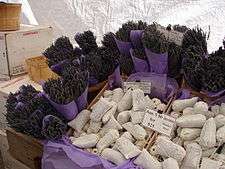
Flower spikes are used for dried flower arrangements. The fragrant, pale purple flowers and flower buds are used in potpourris. Lavender is also used as herbal filler inside sachets used to freshen linens. Dried and sealed in pouches, lavender flowers are placed among stored items of clothing to give a fresh fragrance and to deter moths. Dried lavender flowers may be used for wedding confetti. Lavender is also used in scented waters and sachets.
In history and culture
The ancient Greeks called the lavender herb νάρδος : nárdos, Latinized as nardus, after the Syrian city of Naarda (possibly the modern town of Dohuk, Iraq). It was also commonly called nard.[39] The species originally grown was L. stoechas.[6]
During Roman times, flowers were sold for 100 denarii per pound, which was about the same as a month's wages for a farm laborer, or fifty haircuts from the local barber. Its late Latin name was lavandārius, from lavanda (things to be washed), from the verb lavāre (to wash).[40]
Taxonomic table
This is based on the classification of Upson and Andrews, 2004.
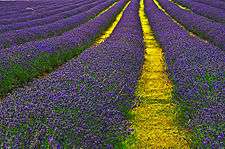
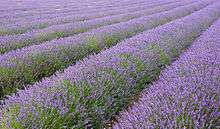
|
I. Subgenus Lavendula Upson & S.Andrews
II. Subgenus Fabricia (Adams.) Upson & S. Andrews
III. Subgenus Sabaudia (Buscal. & Muschl.) Upson & S. Andrews
|
Gallery
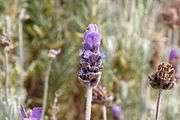 Lavender flower
Lavender flower Flower of cultivated lavender; Lavandula stoechas
Flower of cultivated lavender; Lavandula stoechas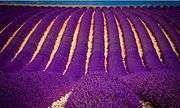 Lavender garden, India
Lavender garden, India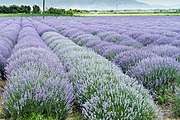 Lavandula fields near Drama
Lavandula fields near Drama
References
- "World Checklist of Selected Plant Families: Royal Botanic Gardens, Kew". kew.org.
- "Outdoor flowering plants - mona lavender". www.hgtv.com. HGTV. Retrieved 19 October 2018.
- "Plant finder - Plectranthus Mona lavender". www.missouribotanicalgarden.org. Missouri Botanical Garden. Retrieved 19 October 2018.
- "Lavender". Drugs.com. 1 November 2018. Retrieved 15 August 2019.
- "Lavender". National Center for Complementary and Integrative Health, US National Institutes of Health. 1 September 2016. Retrieved 15 August 2019.
- Upson T, Andrews S (2004). The Genus Lavandula. Royal Botanic Gardens, Kew 2004. ISBN 9780881926422. Retrieved 2012-03-30.
- L. H. Bailey. Manual of Cultivated Plants. MacMillan Publishing Company.
- Lis-Balchin M, ed. (2002). Lavender: The genus Lavandula. Taylor and Francis. ISBN 9780203216521.
- Chaytor D A. A taxonomic study of the genus Lavandula. 1937
- Concise Oxford Dictionary
- The alternative derivation of the name lavender from Latin livere and medieval Latin lavindula is given in Upson and Andrews, where it is presented as a conjecture. The problems with the standard derivation are also described; such as that there is no knowledge of the common use of lavender for washing by Greeks and Romans.
- Hillier
- Carr, G.W, Yugovic, J.V and Robinson, K.E.. 'Environmental Weed Invasions in Victoria – conservation and management implications' 1992 Pub: Department of Conservation and Environment and Ecological Horticulture, Victoria, Australia
- Csurches S., Edwards R.; National Weeds Program, Potential Environmental Weeds in Australia, Candidate Species for Preventative Control; Queensland Department of Natural Resources. January 1998 ISBN 0-642-21409-3 Also Archived 2007-10-10 at the Wayback Machine
- Grieve, Mrs. M. A Modern Herbal, Vol. II, New York: Dover Publications, Inc., 1971. ISBN 0-486-22799-5)
- Kathleen Norris Brenzel, editor, The Sunset Western Garden Book, 7th Edition
- Ernst, Matt (2017). "Lavender" (PDF). University of Kentucky Center for Crop Diversification.
- Mark Griffiths, Index of Garden Plants (Portland, Oregon: Timber Press, 1994. ISBN 0-333-59149-6.)
- National Non-Food Crops Centre. "Lavender" Archived 2009-11-16 at the Wayback Machine. Retrieved on 2009-04-23.
- "Lavender". Drugs and Lactation Database (LactMed), National Library of Medicine, US National Institutes of Health. 3 December 2018. Retrieved 15 August 2019.
- Umezu, Toyoshi; Nagano, Kimiyo; Ito, Hiroyasu; Kosakai, Kiyomi; Sakaniwa, Misao; Morita, Masatoshi (1 December 2006). "Anticonflict effects of lavender oil and identification of its active constituents". Pharmacology Biochemistry and Behavior. 85 (4): 713–721. doi:10.1016/j.pbb.2006.10.026. PMID 17173962.
- Lavender WhatsCookingAmerica.net
- Pasta With Shredded Vegetables and Lavender Recipe, New York Times, 08.27.2008
- M. G. Kains (1912). American Agriculturist (ed.). Culinary Herbs: Their Cultivation Harvesting Curing and Uses (English). Orange Judd Company.
- "Cooking with Lavender - Purple Haze Lavender (Sequim, WA)". Purple Haze Lavender.
- "Cooking with Lavender?". Chowhound. June 24, 2009. Retrieved 16 February 2017.
- "Cooking With Lavender", Bon Appetit, March 27, 2015
- Stradley, Linda (22 April 2015). "Lavender Scones, Whats Cooking America". What's Cooking America. Retrieved 16 February 2017.
- Maclain, Ben (2 May 2015). "Lavender Marshmallows - Havoc In The Kitchen". Havoc In The Kitchen. Retrieved 16 February 2017.
- "Lavender: 12 Uses Beyond Potpourri". living on a green thumb. October 7, 2015. Retrieved 16 February 2017.
- J.-B. Reboul; Cuisinière Provençale (1910)
- Laget, F. (2005). "From its Birthplace in Egypt to Marseilles, an Ancient Trade: Drugs and Spices". Diogenes. 52 (3): 131–139. doi:10.1177/0392192105055941.
- Kasper, S; Gastpar, M; Müller, WE; Volz, HP; Möller, HJ; Dienel, A; Schläfke, S (2010). "Silexan, an orally administered Lavandula oil preparation, is effective in the treatment of 'subsyndromal' anxiety disorder: a randomized, double-blind, placebo controlled trial". International Clinical Psychopharmacology. 25 (5): 277–87. doi:10.1097/YIC.0b013e32833b3242. PMID 20512042.
- Perry, R; Terry, R; Watson, L. K.; Ernst, E (2012). "Is lavender an anxiolytic drug? A systematic review of randomised clinical trials". Phytomedicine. 19 (8–9): 825–35. doi:10.1016/j.phymed.2012.02.013. PMID 22464012.
- "Expanded Commission E monograph: Lavender flower". cms.herbalgram.org. Integrative Medicine Communications, Germany; from the American Botanical Council. 2000. Retrieved 18 October 2018.
- "Oils 'make male breasts develop'". British Broadcasting Corporation. February 2007. Retrieved 2018-03-17.
- "More evidence essential oils 'make male breasts develop'". British Broadcasting Corporation. March 2018. Retrieved 2018-03-17.
- Placzek, M; Frömel, W; Eberlein, B; Gilbertz, KP; Przybilla, B (2007). "Evaluation of phototoxic properties of fragrances". Acta Dermato-venereologica. 87 (4): 312–6. doi:10.2340/00015555-0251. PMID 17598033.
Also, oils of lemon, lavender, lime, sandalwood, and cedar are known to elicit cutaneous phototoxic reactions, but lavender, sandalwood, and cedar oil did not induce photohaemolysis in our assay...Lavender oil and sandalwood oil did not induce photohaemolysis in our test system. However, a few reports on photosensitivity reactions due to these substances have been published, e.g. one patient with persistent light reaction and a positive photo-patch test to sandalwood oil
- The origin of most of these quotes comes from Dr. William Thomas Fernie, in his book "Herbal Simples" (Bristol Pub., second edition, 1897), page 298:
'By the Greeks the name Nardus is given to Lavender, from Naarda, a city of Syria near the Euphrates, and many persons call the plant "Nard." St. Mark mentions this as Spikenard, a thing of great value. In Pliny's time, blossoms of the Nardus sold for a hundred Roman denarii (or L.3 2s. 6d.) the pound. This Lavender or Nardus was called Asarum by the Romans, because it was not used in garlands or chaplets. It was formerly believed that the asp, a dangerous kind of viper, made Lavender its habitual place of abode, so that the plant had to be approached with great caution.'
- Oxford English Dictionary (second ed.). 1989.
Note however that Upson and Andrews refer to research on bathing in the Roman Empire, and state that there is no mention of the use of lavender in works on this subject.
